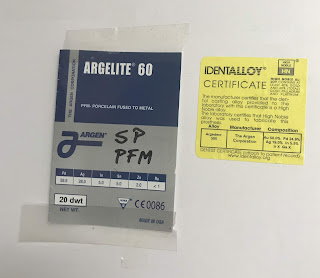The key to taking clear subgingival impressions?
The key to taking clear subgingival impressions is proper retraction, isolation and dry preps that have no bleeding. There are no real short cuts. This patient required subgingival preparations because her teeth were extremely short and needed the retention that a subgingival bevel would afford.
To achieve an excellent impression the dentist should be able to clearly visualize the entire finish line prior to syringing the material. Although this may seem obvious, when I am teaching at dental school, most of the students don't achieve this goal consistently on their own.
There are three components necessary to take an excellent subgingival impression. First there has to be a clear finish line. It needs to be smooth,without steps or ledges. If not, it doesn't matter how good the technique is the crown may not fit properly. Second a wide enough chord should be placed to lightly push on the gum intrasucularly. It is necessary to "expand" the sulcus so that when the chord is removed the gingiva will not bounce back and come in contact with prepped tooth since we can not depend on the pressure of the syringed elastomeric material to displace the gingiva away from the preparation. Third the tooth should be dry, and free of debris and blood. If after the removal of cord there is bleeding, the best thing to do is stop the bleeding with a hemostatic agent (hemodent or ferric sulfate) and if needed repack a single layer of chord dipped in the agent. after gently wetting the chord with water from the three way syringe it can be gently removed without further bleeding and an excellent impression can be achieved.
There are no short cuts and good results take time. It can take between three to six minutes to achieve hemostasis, and pack and one or two chords. Once placed, I wait 4 minutes before removing the cord. The chord should be rewet so that when removed it doesn't cause small tears in the delicate gingiva because it can adhere to it if dry.
After the cord removal I gently wash and dry my prep and make sure to remove any debris that may rest on my preparation. Dry means dry. the preparation should not glisten with moisture. If there is any additional bleeding more hemostatic agent should be applied. I like Viscostat solution since the syringe that Ultradent supplies it has a small plegit at the end that can be used to press on an bleeding spots to help stop minute "bleeders". Sometimes it is necessary to repack my first chord if I see some tissue tags still resting on the the preps margin .
After syringing the elastomeric material and placing the tray in the patients mouth, it is important for the operator to no move the tray while the material sets. Patients should be cautioned not to move around and a gentle but firm pressure should be continuously placed on the tray to keep it from moving.
Although digital impessioning techniques will probably eventually make reduce the need for taking elastomeric impressions, the same principles apply to subgingival digital impressioning, since an optical scanner can only do a good job of capturing what it can clearly see. The entire preparation still needs to be exposed and free of debris and blood.
from Ask Dr. Spindel - http://lspindelnycdds.blogspot.com/2019/08/the-key-to-taking-good-clear.html - http://lspindelnycdds.blogspot.com/


Comments
Post a Comment